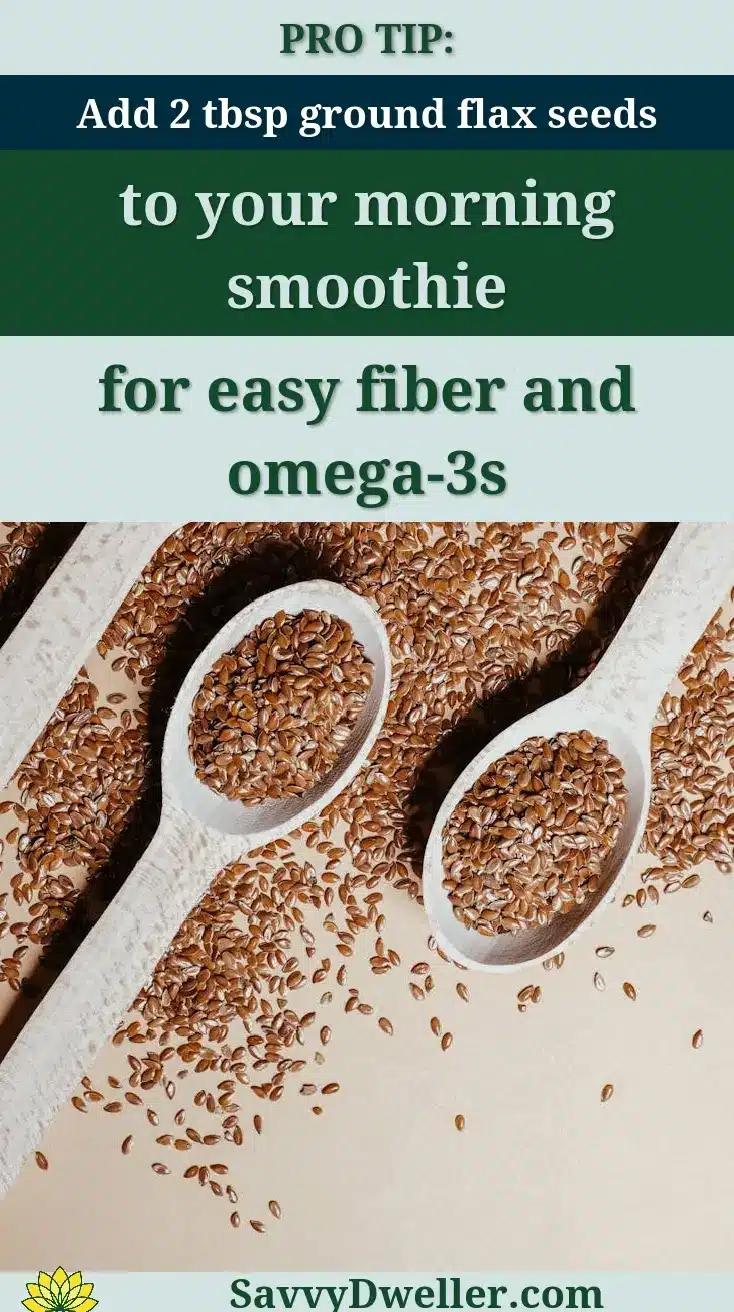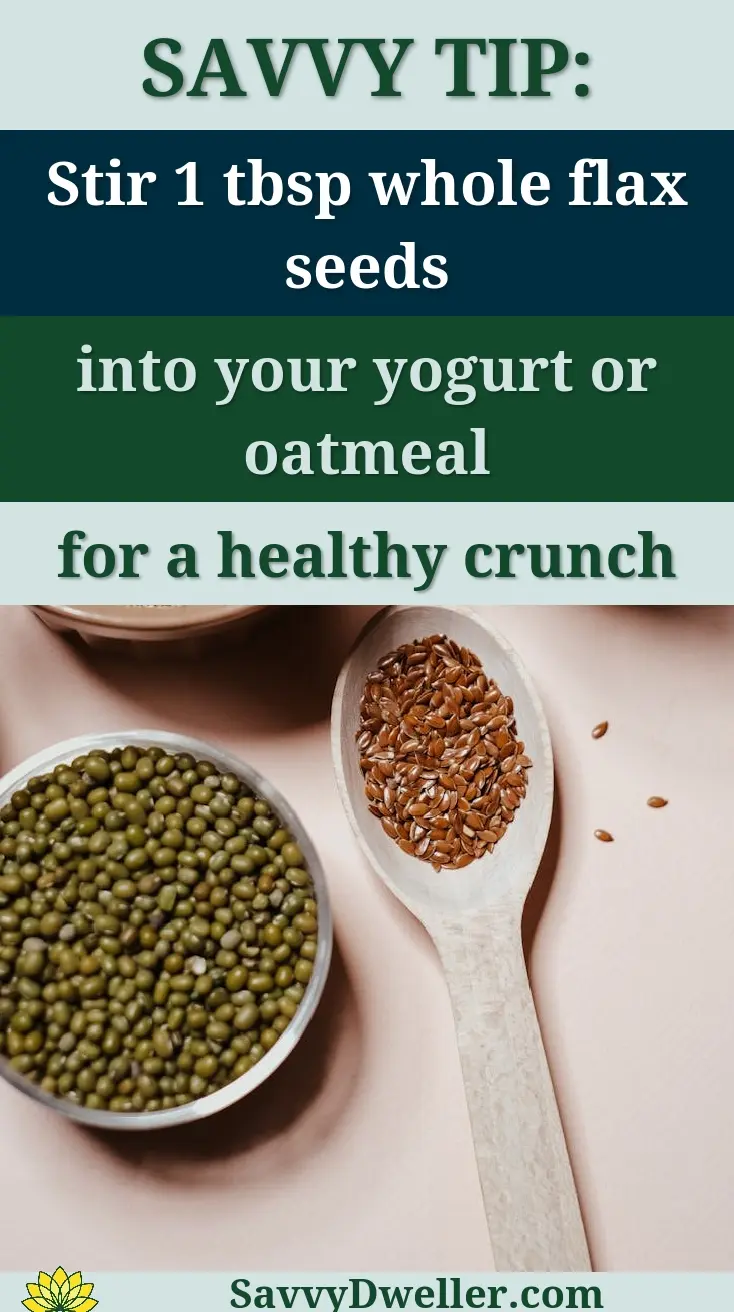Why You Should Add Flax Seeds to Your Diet: 7 Science-backed Reasons for Better Health
Struggling with low energy, digestive issues, or trying to support your heart health naturally? You’re not alone in feeling overwhelmed by conflicting nutrition advice and wondering which “superfoods” actually deliver real benefits. Many people waste money on expensive supplements when simple, whole food solutions might be sitting right in their local grocery store.
Flax seeds offer a powerhouse of nutrients that can support multiple aspects of your health, from heart wellness to digestive comfort. We’ve researched the science behind these tiny seeds and simplified the complex nutritional information into practical, actionable steps you can start using today. You’ll learn exactly how much to eat, the best ways to prepare them, and realistic methods to incorporate them into meals you already enjoy.
Contents
- Quick Solutions Table
- 1. Support Heart Health With Natural Omega-3 Power
- 2. Boost Digestive Health With High Fiber Content
- 3. Aid Healthy Weight Management Naturally
- 4. Support Women’s Hormonal Health
- 5. Provide Powerful Antioxidant Protection
- 6. Support Healthy Blood Sugar Balance
- 7. Easy Ways to Incorporate Flax Seeds Into Your Daily Routine
- Common Mistakes to Avoid When Adding Flax Seeds to Your Diet
- Frequently Asked Questions About Flax Seeds
- Final Words
Quick Solutions Table
Finding the right way to add flax seeds to your diet can feel overwhelming with so many options available. This quick reference table shows you the most effective methods, their specific benefits, and recommended daily amounts to help you make the best choice for your wellness goals.
| Method | Daily Amount | Primary Benefits | Best For | Preparation Tip |
|---|---|---|---|---|
| Ground flax seeds in smoothies | 1-2 tablespoons | Heart health, digestive support | Beginners, busy mornings | Blend well to avoid grittiness |
| Whole flax seeds as yogurt topping | 1 tablespoon | Texture, mild omega-3 boost | Those who prefer crunch | Chew thoroughly for absorption |
| Ground flax in oatmeal | 1-2 tablespoons | Blood sugar balance, fiber | Stable morning energy | Add after cooking to preserve nutrients |
| Flax seed oil supplement | 1 teaspoon | Concentrated omega-3s | Those avoiding fiber | Store in refrigerator, use quickly |
| Flax egg in baking | 1 tablespoon per egg replaced | Plant-based binding, lignans | Vegan baking, egg allergies | Mix with 3 tablespoons water, let gel |
| Ground flax in salad dressing | 1 tablespoon | Antioxidants, healthy fats | Savory meal enhancement | Whisk thoroughly to prevent clumping |
| Flax seed crackers | 2-3 crackers (1 tablespoon seeds) | Portable fiber, satiety | Snacking, weight management | Dehydrate or bake until crispy |
Your body absorbs the health benefits of flaxseed most effectively when you start with smaller amounts and gradually increase. Ground flax seeds offer superior nutrient absorption compared to whole seeds, making them the preferred choice for incorporating flaxseed into diet plans focused on maximum wellness benefits.
The benefits of adding flax seeds to diet routines become most apparent when you choose methods that fit seamlessly into your existing eating patterns. Whether you prefer the convenience of morning smoothies or the versatility of using ground flax in baking, consistency matters more than perfection.
1. Support Heart Health With Natural Omega-3 Power
Your heart works tirelessly every day, and flax seeds offer exceptional cardiovascular support through their rich concentration of plant-based omega-3 fatty acids. These tiny nutritional powerhouses contain more alpha-linolenic acid (ALA) than almost any other food source, making them a heart-healthy addition to your daily routine.
Research shows that regular flax seed consumption may help maintain healthy blood pressure levels and support overall cardiovascular function. The omega-3 content in just two tablespoons of ground flax seeds provides more ALA than many people consume in an entire week.
How Flax Seeds Aid Cardiovascular Wellness
Flax seeds work as natural heart protectors by providing essential fatty acids that your body cannot produce on its own. When you incorporate flaxseed into your diet, you’re giving your cardiovascular system the building blocks it needs for optimal function.
The lignans in flax seeds also contribute to heart health by acting as antioxidants. These compounds help protect your blood vessels from oxidative stress, which can contribute to cardiovascular concerns over time.
ALA Omega-3 Fatty Acids in Flax Seeds
Alpha-linolenic acid makes up about 55% of the total fat content in flax seeds. This essential omega-3 fatty acid supports healthy inflammation response and may help maintain normal heart rhythm.
Your body converts small amounts of ALA into EPA and DHA, the same omega-3s found in fish oil. While the conversion rate is modest, the benefits of adding flax seeds to diet include providing a steady supply of this crucial fatty acid.
Daily Amount for Heart Support
One to two tablespoons of ground flax seeds daily provides approximately 1.3 to 2.6 grams of ALA omega-3s. This amount aligns with many nutritional recommendations for heart-healthy omega-3 intake.
Start with one tablespoon daily and gradually increase to avoid digestive discomfort. Mix ground flax seeds into yogurt, smoothies, or oatmeal for easy incorporation. Flax seeds are among the foods that help relieve constipation.
Flax Seeds Vs Fish Oil Supplements
Many people wonder whether plant-based omega-3s can match the benefits of fish oil supplements. While flax seeds provide ALA rather than EPA and DHA, they offer unique advantages including fiber, lignans, and protein that fish oil lacks.
The health benefits of flaxseed extend beyond just omega-3 content. Unlike supplements, whole flax seeds provide a complete nutritional package that supports multiple body systems simultaneously.
Plant-Based Omega-3 Benefits
Flax seeds offer a sustainable, allergen-free source of omega-3 fatty acids that doesn’t carry the mercury concerns associated with some fish sources. This makes them particularly valuable for pregnant women, vegetarians, and those with seafood allergies.
The ALA in flax seeds also supports brain health and may help maintain healthy cognitive function as you age. Regular consumption provides consistent omega-3 levels without the oxidation concerns that can affect fish oil supplements, making them one of the brain-boosting foods to preserve memory.
Cholesterol Management Support
The soluble fiber in flax seeds may help maintain healthy cholesterol levels by binding to cholesterol in your digestive system. Studies suggest that incorporating flaxseed into diet routines may support improvements in overall lipid profiles.
The lignans in flax seeds provide additional cholesterol management support. These plant compounds may help your liver process cholesterol more effectively, contributing to better cardiovascular health markers.

2. Boost Digestive Health With High Fiber Content
Your digestive system thrives on fiber, and flax seeds deliver an impressive 3 grams of fiber per tablespoon, supporting both digestive comfort and regularity. This high fiber content makes flax seeds particularly valuable for maintaining gut health.
The benefits of eating flaxseeds daily include supporting beneficial gut bacteria growth and promoting healthy digestion. Many people notice improved digestive comfort within just a few days of adding flax seeds to their routine.
How Flax Seed Fiber Supports Your Gut
Flax seed fiber acts like a gentle broom for your digestive tract, helping to sweep away waste and toxins while feeding beneficial bacteria. This dual action supports both immediate digestive comfort and long-term gut health.
The mucilage in flax seeds creates a gel-like substance when mixed with water. This natural gel helps soothe digestive tissues and may provide comfort for those with sensitive stomachs.
Soluble vs Insoluble Fiber Benefits
Flax seeds contain both soluble and insoluble fiber in nearly equal amounts. The soluble fiber dissolves in water to form a gel that helps slow digestion and stabilize blood sugar, while insoluble fiber adds bulk and promotes regularity. This balance of fibers is important as it highlights the key differences between soluble and insoluble fiber.
This balanced fiber profile means flax seed health benefits include comprehensive digestive support. The soluble fiber feeds beneficial gut bacteria, while the insoluble fiber keeps things moving smoothly through your system. For individuals with IBS, a balanced fiber intake is especially crucial since it can help manage symptoms. Adopting a low FODMAP diet can further enhance digestive comfort and may alleviate discomfort commonly associated with IBS.
Supporting Regular Bowel Movements
The high fiber content in flax seeds naturally supports regular elimination by adding bulk to stool and encouraging healthy bowel movements. Many people find this gentler than harsh laxatives or fiber supplements.
Remember to increase water intake when adding flax seeds to your diet. The fiber needs adequate hydration to work effectively and prevent any digestive discomfort.
Ground Flax Seeds Vs Whole Seeds for Digestion
The form of flax seeds you choose significantly impacts their digestive benefits. Ground flax seeds provide superior nutrition absorption and digestive support compared to whole seeds.
Whole flax seeds often pass through your digestive system intact, limiting their nutritional benefits. Ground flax seeds, however, allow your body to access all the fiber, omega-3s, and lignans these seeds contain.
Why Ground Flax Seeds Work Better
Your digestive system cannot break down the tough outer shell of whole flax seeds, but grinding exposes the nutrient-rich interior for optimal absorption. This simple preparation step dramatically increases the benefits of including flax seeds in diet.
Ground flax seeds also mix more easily into foods and create better texture in recipes. You can grind them fresh in a coffee grinder or purchase pre-ground flaxseed meal for convenience.
Also See: Best and Worst Foods for Thyroid Health: A Guide
3. Aid Healthy Weight Management Naturally
Weight management becomes easier when you feel satisfied after meals, and flax seeds naturally support satiety through their unique combination of fiber, protein, and healthy fats. This nutritional trio helps regulate appetite and reduce between-meal cravings.
The benefits of flax seed in diet include supporting healthy metabolism and providing sustained energy. Unlike empty calories from processed foods, flax seeds deliver nutrition that your body can use efficiently.
How Fiber and Protein Support Satiety
Each tablespoon of ground flax seeds provides about 2 grams of protein and 3 grams of fiber, creating a powerful satiety combination that helps you feel full longer. This natural appetite control makes it easier to maintain healthy portion sizes.
The protein in flax seeds contains all essential amino acids, making it a complete protein source. This high-quality protein supports muscle maintenance during weight management efforts. Incorporating a variety of plant-based proteins, like flax seeds, can enhance a balanced diet. Other excellent sources include lentils, chickpeas, and quinoa, which also provide essential nutrients.
Feeling Fuller for Longer
The fiber in flax seeds expands when it contacts liquid in your stomach, creating a natural feeling of fullness. This expansion effect, combined with the protein content, helps reduce hunger hormones and supports portion control.
Many people find that adding flaxseed to diet routines helps them avoid mid-morning or afternoon energy crashes that often lead to unhealthy snacking.
Supporting Healthy Metabolism
The omega-3 fatty acids in flax seeds may help support healthy metabolic function and encourage efficient fat burning. These essential fats play important roles in cellular energy production and hormone regulation.
Regular flaxseed consumption also provides B vitamins that support energy metabolism. This means your body can more effectively convert food into usable energy rather than storing it as fat.
Easy Ways to Add Flax Seeds for Weight Goals
Incorporating flax seeds into weight management routines doesn’t require dramatic diet changes. Simple additions like stirring ground flax seeds into morning yogurt or blending them into smoothies can significantly boost satiety.
Try these practical approaches for adding flax seeds to diet:
- Mix 1 tablespoon into overnight oats or morning cereal
- Blend into protein smoothies for extra thickness and nutrition
- Sprinkle over salads for a nutty crunch
- Stir into Greek yogurt with berries
- Add to homemade energy balls or protein bars
Start with smaller amounts and increase gradually to allow your digestive system to adjust. The health benefits of adding flax seeds to diet become most apparent with consistent daily use.
4. Support Women’s Hormonal Health
Lignans and Phytoestrogens in Flax Seeds
Flax seeds are one of the richest food sources of lignans, plant compounds that act as gentle phytoestrogens. Your gut bacteria convert flax lignans into enterolignans, which can bind estrogen receptors and help modulate estrogen activity rather than overwhelm it. Including flax seeds in your diet can be a smart choice for those looking to support their hormonal balance. In addition to flax seeds, there are several other foods naturally rich in estrogen that can help maintain healthy levels in the body.
This matters for hormonal comfort at any age. The fiber in a benefits flaxseed diet also helps your body excrete used hormones through the gut, supporting a balanced rhythm.
Supporting Menopausal Comfort
Many people use flax seeds to support hot-flash comfort and a steadier mood through menopause. Lignans can provide a mild estrogen-like effect when your own levels dip, while fiber supports smooth estrogen metabolism.
Think of it as a cushion: not a cure, just steady, plant-based support. This is one quiet, practical benefit of adding flax seeds to diet routines during midlife.
Menstrual Cycle Support
Consistent flaxseed benefits include support for regular cycles and easier periods. Lignans may help keep estrogen swings in check, and some studies note higher sex-hormone-binding globulin (SHBG), which can support a calmer hormonal picture.
Fiber also reduces reabsorption of hormones in the colon. That can translate into steadier energy, less bloat, and a more predictable cycle for many.
How Much Flax Seed for Hormonal Support
A practical daily target is 1–2 tablespoons (10–20 g) of ground flax seeds. Ground forms are absorbed better than whole seeds and fit easily into smoothies, yogurt, or oatmeal.
- Start small: use 1 teaspoon daily for 3–4 days to let your gut adjust.
- Increase to 1 tablespoon daily; if comfortable, move to 2 tablespoons after a week.
- Grind fresh (coffee grinder) or buy pre-ground and refrigerate to protect the oils.
- Pair with meals rich in protein or healthy fats for steady release.
- Drink a full glass of water with your serving to keep digestion comfortable.
This steady approach supports the flax seeds health benefits you’re after, without digestive bumps. If you use hormone-related medications, discuss any major diet changes with a healthcare professional. This is especially important if you are considering using flaxseed gel for hair growth.

5. Provide Powerful Antioxidant Protection
Fighting Free Radicals With Lignans
Flax lignans act as potent antioxidants that help neutralize free radicals from stress, UV exposure, and daily living. Your body converts them into enterolactone and enterodiol, which support antioxidant defenses alongside alpha-linolenic acid (ALA) and small amounts of vitamin E.
This trio helps explain why to eat flax seeds if you want a simple, daily buffer against oxidative wear and tear. It’s a smart health habit with broad flaxseed benefits.
Cellular Health Support
Antioxidants in flax support cell membranes and DNA against oxidative stress. That means your cells can do their “repair work” with fewer interruptions.
Think of lignans as tiny shields that keep your cellular machinery humming. This is a core flax seed health benefit behind many long-term wellness gains.
Supporting Healthy Aging
Consistent antioxidant intake supports graceful aging by reducing cumulative oxidative damage. Lignans and ALA work together to support vascular flexibility and brain cell resilience.
Small, daily servings add up over years. That’s the quiet power behind health benefits of flaxseed you can bank on.
Antioxidant Benefits for Skin Health
From the inside out, flax lignans help buffer skin against UV- and pollution-driven oxidative stress. ALA supports the skin barrier, which can aid moisture retention and a calmer look.
- Combine ground flax with vitamin C–rich foods (berries, kiwi) to support collagen.
- Add 1 tablespoon to a morning smoothie for a steady antioxidant drip.
- Stay hydrated to help fiber and antioxidants circulate where they’re needed.
These are practical benefits of including flax seeds in diet plans focused on radiance and resilience.
6. Support Healthy Blood Sugar Balance
How Fiber Aids Blood Sugar Stability
Flax provides soluble fiber (mucilage) that forms a gel, slowing stomach emptying and the release of glucose into the bloodstream. That means smaller post-meal spikes and steadier energy.
Its insoluble fiber feeds gut microbes that produce short-chain fatty acids, which can support insulin sensitivity. This is a standout benefit of flax seeds in diet strategies for steady focus and fewer crashes.
Slowing Sugar Absorption
The gel-like mucilage in ground flax acts like a sponge that slows carbohydrate digestion. Pairing it with carb-heavy meals can temper the glycemic hit.
That’s a practical reason why eat flaxseed with breakfast bowls, wraps, or grain dishes. It quietly smooths the curve.
Supporting Insulin Sensitivity
Fermentable fibers in flax support short-chain fatty acid production, which is linked to better insulin signaling. Flax also supplies magnesium, a mineral involved in glucose handling.
Over time, these small inputs can support a more responsive system. It’s one reason the benefits of eating flaxseeds daily show up in stable energy and fewer cravings.
Best Times to Eat Flax Seeds for Blood Sugar
Timing matters: use flax when carbs show up. That’s how you get the most out of flaxseed benefits diet strategies without overthinking it.
- At breakfast: mix 1 tablespoon ground flax into oatmeal, yogurt, or a smoothie with protein to set a steady tone for the day.
- With carb-heavy meals: sprinkle 1 tablespoon over rice, pasta, or tacos to slow the glucose rise.
- Pre-meal booster: stir 1 teaspoon ground flax into water, let gel 5 minutes, and sip 10–15 minutes before eating.
- Snack safety net: stir into hummus or cottage cheese to blunt a sweet snack’s impact.
- Spread your servings: two 1-tablespoon doses (lunch and dinner) can support all-day balance.
This simple timing makes the health benefits of adding flax seeds to diet plans both practical and noticeable. If you use glucose-lowering medication, check in with a clinician before making big shifts.
7. Easy Ways to Incorporate Flax Seeds Into Your Daily Routine
Simple Morning Additions
Smoothies and Yogurt
Blend or stir 1–2 tablespoons of ground flax seeds into your breakfast for a quick fiber and omega-3 boost. This simple habit supports the benefits of eating flaxseeds daily without changing your routine.
- Materials: Ground flaxseed (flaxseed meal), fruit, milk or milk alternative, yogurt or kefir, optional cinnamon or cocoa.
- Good pairings: Banana + peanut butter, berries + vanilla yogurt, mango + ginger.
- If you have whole seeds, grind them first for better flax seed health benefits.
- Add 1–2 tablespoons ground flax to your smoothie ingredients and blend 30 seconds.
- For yogurt: stir in 1 tablespoon, wait 5 minutes to thicken, then add fruit or nuts.
- Prefer meal prep? Freeze smoothie packs and sprinkle flax in right before blending.
Ground flax thickens yogurt and smoothies naturally, creating a creamy texture and steady energy. That’s a simple benefit of adding flax seeds to diet routines you already enjoy.
Oatmeal and Cereal
Stir ground flax into hot oatmeal at the end of cooking to keep flavor fresh and nutrients intact. It also works as a crunchy topper for cold cereal or overnight oats.
- Materials: Cooked oatmeal or cold cereal/muesli, ground flaxseed, fruit, milk, cinnamon.
- Portion guide: 1 tablespoon for a start, 2 tablespoons for a hearty bowl.
- Cook oats as usual, then remove from heat.
- Stir in 1–2 tablespoons ground flax; add a splash of milk if too thick.
- Top with berries and cinnamon for a balanced bowl.
- For overnight oats, mix flax in before chilling to create a pudding-like texture.
This routine supports flax seeds and health benefits like steady fullness and regularity. It’s an easy win for the benefits of flax seeds in diet choices you already make.
Creative Recipe Ideas
Baking with Ground Flax Seeds
Swap 10–20% of flour with ground flaxseed in muffins, pancakes, quick breads, and waffles. You’ll add fiber, lignans, and plant-based omega-3s without losing flavor.
- Materials: Ground flaxseed, your usual baking mix, extra liquid (milk or water), leavening.
- Best uses: Banana bread, blueberry muffins, oat pancakes, energy bites.
- Measure your flour, then replace 2–4 tablespoons per cup of flour with ground flax.
- Add 1–3 extra tablespoons of liquid per 1/4 cup flax to keep bakes moist.
- If batter seems dense, increase baking powder by 1/4 teaspoon.
- Bake as usual; ground flax holds up well at typical baking temperatures.
In baking, incorporating flaxseed into diet plans is seamless-taste stays familiar while nutrition climbs. This is a practical way to gain flaxseed benefits diet lovers appreciate.
Flax Seed Egg Substitute
Use a “flax egg” when you need a binder in vegan or egg-free baking. It works well in pancakes, cookies, and quick breads.
- Materials: 1 tablespoon ground flaxseed, 3 tablespoons warm water (per egg), small bowl, whisk.
- Best for: Cookies, brownies, muffins, pancakes. Not for airy cakes or meringues.
- Whisk 1 tablespoon ground flax with 3 tablespoons warm water.
- Rest 5–10 minutes until it gels.
- Use in place of 1 egg in most baked recipes.
- For darker bakes, use brown flax; for lighter color, use golden flax.
This swap supports the health benefits of adding flax seeds to diet patterns while keeping recipes flexible. It’s a smart way to get flaxseed benefits without changing flavor.
Storage and Preparation Tips
Grind close to use and keep ground flax cold, dark, and airtight to protect freshness. That’s how you preserve flaxseed health benfits from ALA and lignans.
- Whole seeds: Store in a cool pantry up to a year; grind in a coffee or spice grinder for 10–15 seconds.
- Ground flax: Refrigerate up to 3–4 months or freeze up to 6 months in an airtight, opaque container.
- Freshness check: It should smell nutty, not like paint or putty.
- Serving cheat sheet: 1 tablespoon ground flax ≈ 7 grams; many people use 1–2 tablespoons daily.
- Buy whole seeds for longest shelf life, or choose vacuum-sealed flaxseed meal.
- Grind small batches weekly to capture flaxseed rbenefits without waste.
- Label the container with the grind date and keep it away from heat and light.
- Stir ground flax into foods after cooking when possible for best aroma.
These habits make the benefits of including flax seeds in diet plans reliable day after day. That’s why to eat flaxseed in a way that stays budget-friendly and tasty.
Common Mistakes to Avoid When Adding Flax Seeds to Your Diet
Starting With Too Much Too Quickly
Jumping to big servings can cause bloating or discomfort. Let your gut adjust gradually to get the most flaxseed benefits.
- Begin with 1 teaspoon daily for 3–4 days.
- Increase to 2 teaspoons, then 1 tablespoon.
- Work up to 1–2 tablespoons per day as you feel comfortable.
This slow build supports the benefits flaxseed diet fans want without side effects. It’s a gentle way to enjoy flax seed benefits.
Not Drinking Enough Water
Flax’s fiber absorbs water; too little fluid can backfire. Hydration helps the fiber do its job smoothly.
- With each tablespoon of ground flax, drink at least 8 ounces of water or herbal tea.
- Space servings across the day if you’re new to higher fiber.
Good hydration helps deliver flax seeds health benefits like regularity and satiety. That’s a simple fix for why eat flax seeds without discomfort.
Using Whole Seeds Instead Of Ground
Whole flax seeds may pass through undigested, limiting flaxseed added to diet benefits. Grinding makes nutrients more available.
- Grind whole seeds in a spice grinder for 10–15 seconds to a fine meal.
- Store ground flax cold; sprinkle into meals you already eat.
Ground flax supports the full health benefits of flaxseed you’re aiming for. That’s the practical benefit of adding flax seeds to diet staples.
Improper Storage Leading to Rancidity
Heat, air, and light can degrade flavor and nutrients. Freshness matters for flaxseed health benfits you can count on.
- Keep ground flax in the fridge or freezer in an airtight, opaque container.
- Buy smaller bags or grind weekly to reduce waste.
- Do a smell test; if it smells like paint, discard.
Careful storage preserves flaxseed benefits and taste. It keeps the benefits of flax seed in diet routines consistent.
Not Checking With Healthcare Providers
If you use blood-thinning medications, manage blood sugar, have a history of bowel narrowing, or have hormone-related concerns, talk with your clinician before making big changes. This keeps adding flaxseed to diet plans safe and personalized.
- Ask about timing with medications and total fiber goals.
- Share how much flax you plan to use (for example, 1–2 tablespoons daily).
That quick conversation respects your health context while you enjoy why eat flaxseed in everyday meals. Thoughtful planning helps you capture flax seeds and health benefits comfortably.

Frequently Asked Questions About Flax Seeds
Are Flax Seeds Safe for Pregnant Women and Children?
Flax seeds are generally safe, but pregnant women should consult their healthcare provider before consuming them regularly. While the omega-3s can support fetal brain development, the phytoestrogens in flax seeds may affect hormone levels, so professional guidance is advised. For children, introduce small amounts (e.g., 1/2 teaspoon of ground flax daily) and monitor for digestive tolerance, as their systems are more sensitive.
Can Flax Seeds Interact With Medications?
Yes, flax seeds may interact with certain medications, particularly blood thinners like warfarin or aspirin, due to their blood-thinning effects from omega-3s. They can also affect blood sugar levels, so people taking diabetes medications should monitor their levels closely and consult a doctor. Always discuss adding flax seeds to your diet with a healthcare provider if you are on prescription drugs.
What is the Difference Between Flax Seeds and Chia Seeds?
Flax seeds are richer in alpha-linolenic acid (ALA) omega-3 fatty acids, while chia seeds have more fiber per serving. Flax seeds must be ground for optimal nutrient absorption, whereas chia seeds can be eaten whole and form a gel-like consistency when soaked. For specific goals, choose flax for heart health and chia for hydration and fiber boosts in recipes like puddings. Incorporating chia seeds into your diet can offer a range of health benefits. In fact, they are known for their role in improving digestion, enhancing hydration, and providing essential nutrients.
Is Flax Seed Oil As Beneficial As Whole or Ground Flax Seeds?
Flax seed oil provides concentrated omega-3s but lacks the fiber and lignans found in whole or ground seeds. It’s great for dressings or supplements but won’t support digestion or hormonal health like the whole seed. For full benefits, use ground flax seeds in meals and reserve the oil for cold uses to avoid destroying sensitive nutrients with heat.
Final Words
Adding flax seeds to your daily routine doesn’t have to be complicated or overwhelming. Start with just one teaspoon per day, sprinkled into your morning smoothie or yogurt, and gradually work up to the recommended 1-2 tablespoons. Remember to drink plenty of water and choose ground flax seeds over whole ones for maximum nutrient absorption.
These tiny nutritional powerhouses can support your heart health, digestion, weight management, and so much more when used consistently. The key is finding simple ways that work with your lifestyle, whether that’s mixing them into baked goods, using them as an egg substitute, or simply stirring them into your oatmeal.
Ready to give your health a natural boost with flax seeds? Start tomorrow morning with one small addition to your breakfast routine. For more practical wellness tips and home solutions that actually work, check out Savvy Dwelling where we share research-backed advice to help you live better every day.


